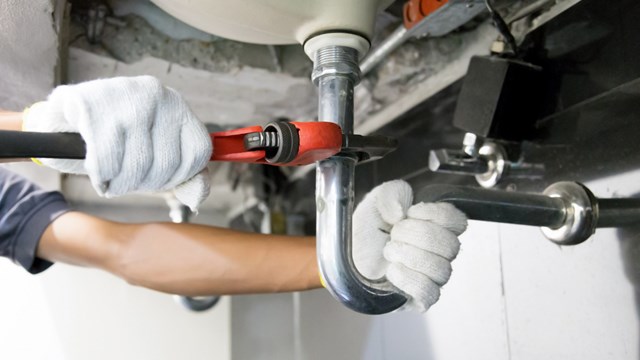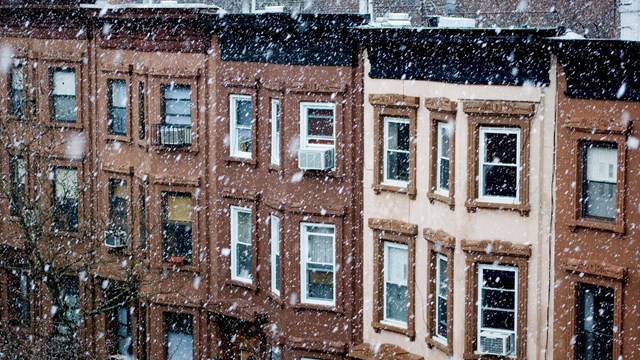Of all the problems that can befall a residential building over the course of its long, eventful life, perhaps none is more insidious and damaging than water leakage and infiltration. Water leaks are hard to triangulate and hard to stop, and their long-term aftereffects are often hard to remediate. From the stains and mildew caused by a neighbor's flooded bathroom to a building-wide mold problem triggered by a compromised roof, water damage is frustrating, expensive, and can even pose serious health risks to a building's occupants.
Of course, the first step to dealing with leaks is preventing them in the first place. While a complete roof replacement is a massive, expensive project, keeping the roof you have in good repair can spare your building the capital outlay of a new roof for many fixing consequential water damage in shareholders' apartments.
While a roof-and-façade inspection can be done at almost any time of year, spring is the most logical time to bring a waterproofing specialist into your building to check out the condition of your roof and walls. According to Lori Simon, director of marketing for Manhattan's Kay Waterproofing, the most common cause of leaks and water damage in any building is not flooding of Biblical proportions, or a roof torn off by gale-force winds; it's the slow grind of the passing seasons, negligent maintenance of the roof and façade, and just plain old Father time.
"Sleet, snow, and wind can damage mortar and caulking sealants, and the weight of snow on a roof can compromise the flashing system, which allows water to penetrate beneath the structural deck. If your roof was in need of attention before the bad weather set in, cracks, damaged seams, and bulges in the membrane just worsen over the course of the season," says Simon.
And if your building ponied up for a new roof that wasn't done with the utmost competence and care trouble spots could certainly lie ahead., according to Andrew Wist, president and CEO of Standard Waterproofing & Roofing in the Bronx. "If a new roof leaks within the first season is up, it'll leak forever. It doesn't matter how often you fix it - if it was done poorly to begin with, it'll be a nightmare," says Wist.
To find out what kind of shape your roof and façade is in, waterproofing pros have a number of methods and equipment at their disposal. According to Wist, "We have equipment that runs over the roof and sends electrical charges through that detect the presence of water. It looks almost like a broom - we run it across the roof, it tells us where the water is. On the other hand, some of our guys have been doing this kind of work for 20 or 30 or more years, and sometimes they can look at a leak and boom, they know where it's coming from."
And where the water's coming from can be a very tricky question to answer. Water moves, and so while Ms. Jones in apartment 6B may be furious at Mrs. Smith in 7B and blame her for causing Ms. Jones' ceiling to leak, the real source of the water may be floors away on the opposite side of the building.
According to Simon, "The point of entry is usually far removed from where an actual leak will show up. You can have a leak forming on the parapet wall that ends up several floors down in Ms. Jones's apartment. Water travels where it wants - sometimes it'll seem that the leak is on someone's outside wall, and it's coming from somewhere entirely different."
That means that waterproofing technicians have their work cut out for them when they're on the trail of a leak. They generally track the point of entry by going into the apartments above, below, and adjacent to the problem area, as well as out onto the roof, and inspecting window seals, sills, and lintels. A thorough inspection, says Wist, will also cover "drains, pitch-pockets, and seams where the walls meet the roof - any place two surfaces come together is a potential site for leakage."
Inspectors will also pay close attention to chimneys, says Simon. "Water can come in through gaps where sulfuric acid [from burned fossil fuels] from having to run the heating systems overtime all winter has eaten away the chimney lining."
Chasing down water leaks is a very complicated, involved process, and while some waterproofing firms will do a cursory visual inspection free of charge, a more detailed vetting of your building will cost you. The price for a full survey and assessment varies greatly depending on the size of your building, its age and condition, and the number of exposed faces, but generally, you can count on things starting in the $1,000 range and going upwards from there.
The reasons for doing a survey are multiple, says Simon. "Your building engineer, contractor or staff can monitor the structure for leaks, and you can also perform a visual inspection with field binoculars, looking for bulged masonry, larger cracks, and open mortar joints, but a full survey [by a pro, on a scaffold] is a good idea, both to give your board a comprehensive overview of your building's structural health, and to fulfill your due diligence to shareholders," she says. "If problems are repaired now, you'll save money in major repairs down the line."
While you as a homeowner can't prevent every pipe leading into your apartment from breaking or getting clogged, you can avoid watery trauma by exercising care in what you put down your sink drains - avoiding materials that could clog or back up in the drainpipes - by monitoring bathtubs and shower stalls when the water is turned on, and by seeing to it that any large, high-consumption washing appliances are properly installed, with their hoses firmly attached, free from kinks, and adequately maintained.
It's also vital that you immediately report leaks - even suspected ones - to your building manager or superintendent so the problem can be addressed before it snowballs into a bigger one; like mold. Mold contamination, which has gotten an incredible amount of press recently - and cost some buildings hundreds of thousands of dollars in repair and litigation costs - is inextricably tied to the matter of water leaks and damage. Wherever there is moisture, there is the potential for mold infiltration. When water seeps into the spaces between wall studs, or saturates building materials, it's quite likely that mold spores will flourish there, creating huge problems for boards, management, and building residents - not only in terms of repairing the affected areas of the building, but because of the health impact mold infestation can have on apartment owners.
Old caulking, worn-out window seals, and deteriorating pipes in the kitchen or bathroom are just a few easily-fixed problems that can all allow water to infiltrate the building envelope and give mold spores a foothold if they're not attended to quickly. Putting off reporting or dealing with a leakage problem can lead to serious disruptions for building residents, above and beyond the original problem.
"Usually, by the time a waterproofer is called in, the leak's been going on for a while," says Wist. "Luxury buildings tend to act faster, but usually, it takes a while - but if you let a leak go, you're going to have to start cutting holes in walls to deal with the mold - stripping sheetrock, scrubbing underlying brick - and, by the time you see [mold], it's too late already."
Simon agrees that once you see mold and mildew on a wall, the game is up. "If you're talking about that level of infiltration, that wall has got to come down," she says. "For a mold issue, it won't just be a small leak that's causing beehiving or bubbling on a wall; it's going to be a major leak."
If your wall or ceiling is damp, but you don't see signs of mold contamination, a waterproofing company can tell you just how bad the situation really is by inserting a moisture meter probe into the wall to measure how much moisture is behind it. If it's determined that the environment is ripe for a problem, the waterproofer can sit down with the board and the affected shareholder or unit owner and work out a remediation plan.
The last thing a board wants to hear is that the roof of their building is leaking, or that the façade has deteriorated to the point where something must inevitably be done. Repairs of this kind can be astronomically expensive, time-consuming, and, needless to say, disruptive. So, the best way to avoid having to bite the bullet and launch a major repair project is to inspect your building regularly for damage that could lead to leaks; another is to inform residents that it's their responsibility to the building community as a whole to abide by appliance and water-use rules, and to report any flooding or leakage immediately to the building super or managing agent so that it can be fixed immediately.
Another way residents can help if there's a leakage problem is to cooperate with waterproofing experts and building staff, making sure workers have access to their apartments if necessary. Says Wist, "We've got to get into Ms. Jones's apartment to see where the water's leaking. If we do a water test on the roof and plug a drain, for example, we need access to the leaking apartment. We have to have one guy on the roof or upstairs working with the drain, and another in the apartment to monitor the other end." If the waterproofers can't get into the leaky apartment, they can't fix the leak, and the problems will continue.
By the same token, it's the responsibility of the board and managing agent to make sure leaks are taken seriously and dealt with in a timely and decisive manner. It's important to heed the concerns or complaints of shareholders who feel like they're living in a sieve, according to Simon. "New plaster or a coat of paint may help for a while," she says, "but that only resolves additional expenses and irate tenants [temporarily]."
In the end, a water problem will likely take more than a quick-fix and a strong sense of denial to properly address. Next to noise, water leaks are probably the number-one complaint of apartment-dwellers and the bane of board members, managing agents, and supers alike. For all its benefits and necessity, water can cause big problems for buildings both large and small - and the best strategy for dealing with leaks is to stay on top of things and not let complacency lead to complication.







Comments
Leave a Comment